Pacific Northwest Ballet / City Center, NYC / February 13-16, 2013
The Pacific Northwest Ballet, whose home is in Seattle, has just made a rare visit to New York. It offered two programs, one an acid-test rep of three top-of-the-line Balanchine classics; the other, Jean-Christophe Maillot’s take on Romeo and Juliet, to that Prokofiev score ballet fans hear far too often. Evolved by Francia Russell and her husband, Kent Stowell, in the course of the 1970s, the company is one of several groups whose roots lie in Balanchine territory. Peter Boal, a celebrated New York City Ballet alum known for the purity and exactitude of his dancing and his insightful teaching has been PNB’S Artistic Director since 2005. The company brought its own conductor, the highly regarded Emil de Cou, as well as its own orchestra.
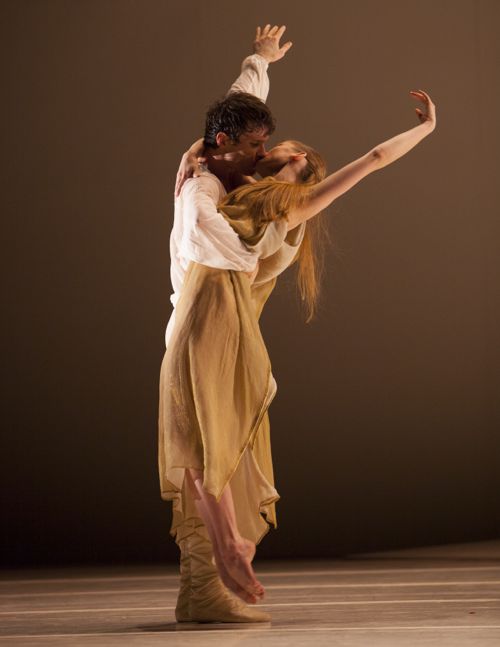 Pacific Northwest Ballet’s stars Carla Körbes and Seth Orza
Pacific Northwest Ballet’s stars Carla Körbes and Seth Orza
Photo: Angela Sterling
It turned out, for once, that the promotion department had it right. They put all their chips on the company’s singular ballerina, Carla Körbes, who, as chance would have it, danced Terpsichore to Peter Boal’s Apollo in her native Brazil at the age of 14. And danced it here on opening night, proving to New Yorkers that she’s not only what the publicists claimed she was, but far more. For the record, it was in Balanchine’s last (and thus official) version of the piece that she performed—no birth, no stairway to the stars. I must say I still miss those passages.
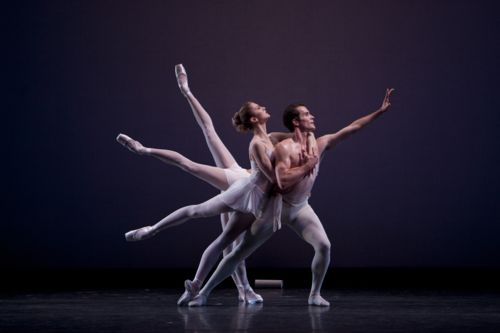 Pacific Northwest Ballet dancing George Balanchine’s Apollo, Carla Körbes and Seth Orza in foreground
Pacific Northwest Ballet dancing George Balanchine’s Apollo, Carla Körbes and Seth Orza in foreground
Photo: Lindsay Thomas
Körbes has the delicious face and body of a charmer in a Fragonard painting, not a single ballerina mannerism (go see for yourself if you can’t believe me; I could barely believe it), lovely technique—strong and correct, effortless in appearance—and a playful quality that seems a part of her personal temperament. On opening night, she danced Terpsichore again, this time with Seth Orza; Peter Boal staged the production.
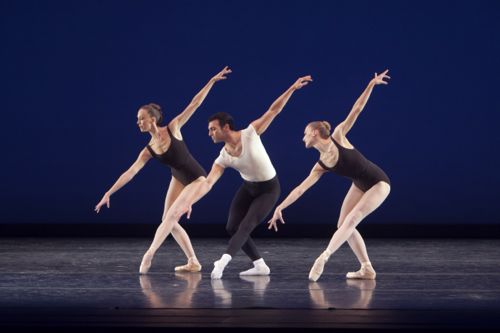 A PNB trio in Balanchine’s Agon (l. to r., Kylee Kitchens, Jonathan Porretta, and Elizabeth Murphy
A PNB trio in Balanchine’s Agon (l. to r., Kylee Kitchens, Jonathan Porretta, and Elizabeth Murphy
Photo: Lindsay Thomas
The two leading dancers—just like the other two muses represented in the ballet—made clear and specific some of the details that other companies skim over. Granted, PNB leaves nothing unconsidered, occasionally to a fault, yet it never once falls into the trap of the mechanical. The dancers move as if this glimpse of teaching the youthful Apollo to be a god (for example, balancing the prone Terpsichore on the nape of his neck) is utterly confident and secure—an attribute I’ve never witnessed before, despite decades of watching Apollo. This sort of marvel makes you think of the ballet as a miraculous event, coalescing perfectly at unpredictable intervals. The truth is that Körbes regularly dances within this dimension.
It should be mentioned that Körbes’ engagement, earlier in her career, with City Ballet simply did not work out, despite her rare gifts. Now in her early thirties, she is no “baby ballerina”—but she has come into her own. One can only be grateful.
Among the men of PNB, I most admired Seth Orza, a former City Ballet soloist who danced with welcome confidence in his presence. Jonathan Porretta, too, performed with a fine spirit. And there’s a wonderful loose-jointed young man with reddish hair called Andrew Bartee who looks as if he’s made for great things. A majority of the men, though, lacked sufficient authority and energy—that “Here I am! Look at me!” quality—the absence of which can be more defeating than any lack of technical acumen.
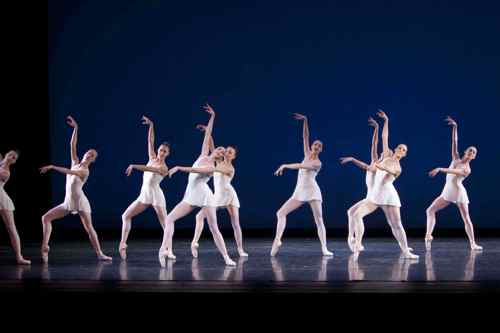 Balanchine’s Concerto Barocco, danced by members of the Pacific Northwest Ballet
Balanchine’s Concerto Barocco, danced by members of the Pacific Northwest Ballet
Photo: Lindsay Thomas
My PNB enthusiasm wilted drastically with the performance of the two Balanchine masterworks staged by Francia Russell: Concerto Barocco and Agon. These renditions were at best “nice.” Only very occasionally did the dancers look as if they recognized shifts in the music’s rhythm, tone, instrumentation, et al. as factors to be embodied or debated with. The music was treated almost as an element of decoration, rather than as the heartbeat of the choreography. And nowhere did the dancers activate the space through which they moved. (Where is Mary Wigman when we need her?) The most inexplicable example of the Russell approach is to give us the celebrated pas de deux in Agon utterly devoid of its sexual element. What did she think these people were doing?
PNB would never have come into being without Russell’s decades of dedicated labor. I admire her for that and sometimes regret that I’ve vowed as a critic to tell the truth as I see it. Dissenters should remember that mine is just one person’s opinion.
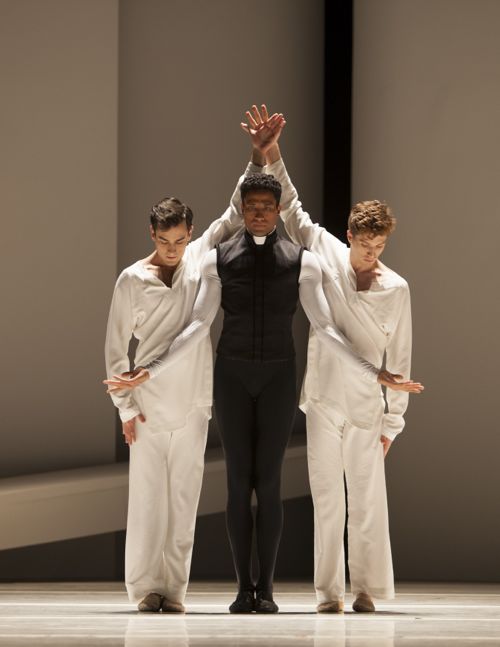 PNB’s dancers in Jean-Christophe Maillot’s Roméo et Juliette with Karel Cruz (center) as Friar Laurence and (l. to r.) Jerome Tisserand and Andrew Bartee as his acolytes
PNB’s dancers in Jean-Christophe Maillot’s Roméo et Juliette with Karel Cruz (center) as Friar Laurence and (l. to r.) Jerome Tisserand and Andrew Bartee as his acolytes
Photo: Angela Sterling
For the second of its two programs, the company walloped us with its three-hour (one intermission), hyperactive Roméo et Juliette, by Jean-Christophe Maillot—for which Olympic-grade stamina is required of the dancers as well as considerable patience and book-learning from the audience. Even certified English majors (count me among them) will have some problems figuring out who’s who and what’s happening to her/him. As for why this or that is occurring, I believe we’re meant to feel it’s just fate; or the anything-goes environment; or the lack of parental authority (Juliette has no dad to lay down the law in this version of the story); or raging hormones. Apparently Friar Laurence—albeit slightly inept but traditionally a source of comfort in ballets well-rooted in Shakespeare’s play—has a much inflated and mixed (read “confused,” “up to no good”) agenda and cannot be trusted. To put it mildly. Are we to think he’s a worker of black magic? Is he insane? Is he an instrument of fate? Of bad karma? Surely the viewer deserves more concrete explications of M. Maillot’s imaginings
What other information can I offer? The male dancers knocked themselves out portraying a hearty crew of boys being boys. Romeo (Seth Orza) was sweet, though hardly irresistible, and determined to possess his latest beloved (remember Rosaline, his girlfriend of yesterday?), but hardly a Justin Bieber heartthrob. Juliet’s Nurse (Rachel Foster) and our heroine’s wayward mom (Laura Gilbreath) lacked a truly concerned commitment to the girl who was presumably their responsibility. Körbes, the first-cast Juliette, looked exhausted, both physically and emotionally, long before the tale had played itself out. The women of the corps were graceful and, thanks to the designer Jérôme Kaplan, attractive in their wafting dresses. (Juliette even rates cloth-of-gold at one point.)
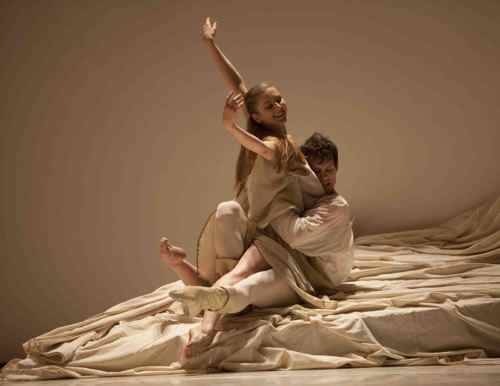 PNB’S Carla Körbes and Seth Orza on their wedding night in the title roles of Maillot’s Roméo et Juliette
PNB’S Carla Körbes and Seth Orza on their wedding night in the title roles of Maillot’s Roméo et Juliette
Photo: Angela Sterling
The “upscale” program notes are in love with adolescence, and the choreography offers a detailed dissertation on learning to love (for example, the evolution of the kiss). Nevertheless the dancers’ rough and tumble existence, including the lovemaking, is crammed with knockabout playfulness. Other elements, many of them critical to plot cohesion, are blithely ignored.
Perhaps there should be an Inquisition to examine new ballets for their believability flaws. Maillot’s R&J has no class structure or explicitly clear definition of clans—Capulet versus Montague. None whatsoever. Yet this is the element that, in Shakespeare’s telling, sets up the tale’s basic situation. Juliette, a young woman supposedly from an important and moneyed family, would never consider the teenage street kids, if, indeed, that’s what they are, to be her social equals. And even a choreographer as contemporary as Jerome Robbins, whose work suggests that adolescence was his favorite among the stages of life, had to have his volatile teens ultimately answerable to their society. Aside from Peter Pan, few imaginary personages manage to stay permanently young and unfettered.
The ballet’s set, by Ernest Pignon-Ernest, is essentially abstract and all white, including the floor cloth. It looks more sterile than an operating room. On the other—and more significant—hand, the orchestral accompaniment, led by Emil de Cou, was considerably finer than our big local troupes enjoy.
I salute the PNB dancers and the viewers who remained patient and enthusiastic throughout the show and can only hope they will read or reread Shakespeare’s text, if just to set their minds straight about what was going on in Verona.
© 2013 Tobi Tobias




“One can only be grateful[that Carla Korbes has matured into a world-class ballerina]”. Yes.
Maillot’s R&J is definitely an odd and confusing piece of work, and only rarely dramatically persuasive. For me, the portrayal of the Nurse was particularly unpleasant and made it the most thankless role for a performer. It was particularly annoying that in Juliet’s first scene, Maillot introduces the Nurse to Juliet’s scampering, bounding music, having her fuss around and dust her chair — and then has Juliet enter to the more stately tempo that usually signals her mother’s entrance. But while the ballet might have felt like three hours, both performances I attended clocked in at two hours and 20 minutes.
All I can assume is that my growing apathy to the proceedings slowed my internal clock–and my watch! Actually the whole show threatened to go on for eons and STILL we didn’t know what Friar Laurence was “about.” Yes, I read the program notes, but, although Heidi never lies, program notes do so congenitally.
Nice review Tobi. Agreement on everything, except I also wanted Seth Orza to to lighten up as Apollo.
music as the “heartbeat” of choreography
so pure
thanks
That the Russell/Stowell regime was a mixed bag and blessing and less than wonderful art is seemingly unavoidable, but this quote from Tennessee Williams that’s been going around puts it well, I think:
“You have to realize that the vast majority of things attempted in the arts aren’t good. They are attended by great hope and ambition and good intentions, but it is very hard to create anything of value in the arts. Accept this. It is also . . . the reason we love so much the great play or the exquisite piece of music or the work of art that speaks to all people. These are big and rare and wonderful things. Most things are bad. Somehow you have to ignore and erase the effects of these bad attempts while also supporting and caring for the well-meaning siblings who did the bad work. Something good may eventually happen; something of merit may appear. Shield yourself while at the same time extending kindness. This is, I think, one of the hardest and noblest acts of the artist.” –Interview with James Grissom, 1982.
One thing I miss about the days when I worked in theater was that I saw a lot of art, and living in NYC, art of all kinds, so I was able to see it as a continuum, like the year’s seasons and not performances as individual delights or disappointments. But, face it, some continua are nicer and more successful artistically than others. Sigh.
I was originally scheduled to see only PNB’s all-Balanchine program, but a friend in Seattle persuaded me to see Romeo and Juliette as well. The highlight of PNB’s visit to City Center for me was Carla Korbes’ performance as Terpsichore in Apollo. Also, I was pleased that the company had the luxury of bringing its own orchestra and acclaimed conductor Emil de Cou. I saw R&J at the matinee without Ms. Korbes but the company danced with spirit. The chic costumes in a sophisticated palette were arguably the best thing about this production. I understand the scenery and costumes are new; I regret that money was wasted on this pretentious hokum.
As I recall, the last time I saw Apollo performed with “stairway to the stars,” etc.” was with the Suzanne Farrell Ballet in Brooklyn with Peter Boal exemplary in the title role.
Thank you for the perceptive, as usual, review of Pacific Northwest Ballet’s Balanchine program. I did not see the R&J.
Thanks for your review. Isn’t it odd that they gave only one performance of the Balanchine programme? As a second programme, they could easily have brought Balanchine’s Midsummer instead of this Romeo. I remember PNB danced Midsummer very well indeed.
It’s amazing how with every new R&J like this one, MacMillan’s seems retroactively elder, more a work of genius. I wonder if the MacMillan trust pays them off.
While clearly flawed, PNB’s R&J held my interest throughout. Never once did I wish I were seeing the MacMillan version. (All that street sweeping and repetitious harlot dancing was not missed!). I found by using music usually used for other characters, Maillot allowed me to hear the score in a new and fresh way–that, and the extraordinary execution by the PNB orchestra!. I also appreciated the use of a stripped-down set and costumes. And, for the most part, the dancing and dancers were never less than absorbing. Maybe because we don’t see these dancers very often, I found myself thrilled at their youth and energy. A most interesting company. With any luck, they will return more frequently to NYC.
I, too, was struck by the elegance of “music as the heartbeat of choreography.”
I had never seen the company before but I agree they aren’t what I would call strong. Carla Korbes was such a standout; nobody else in the company came near her. I had the feeling Seth Orza had jitters on opening night (Apollo) and might not have been at his best. I also think the company is not going to improve doing pieces like this R&J.
However sad it may be to think that, with all the resources at his command, Boal hadn’t been able to show us his true vision of Balanchine, it’s sadder to think that he had.
I think you hit the nail on the head with your comments about Russell. I’d read so much praise for her Balanchine stagings, I had a hard time imagining that she was the source of all that flaccidity on stage. But what else could it have been? Surely Peter knows better. Despite all the praise for Carla Korbes, every other dancer in the company moves like they’d never laid eyes on her before.
I admire your fortitude and powers of observation in cataloging so many of the things wrong with Maillot’s R+J. After awhile, I decided life was too short, and bailed.